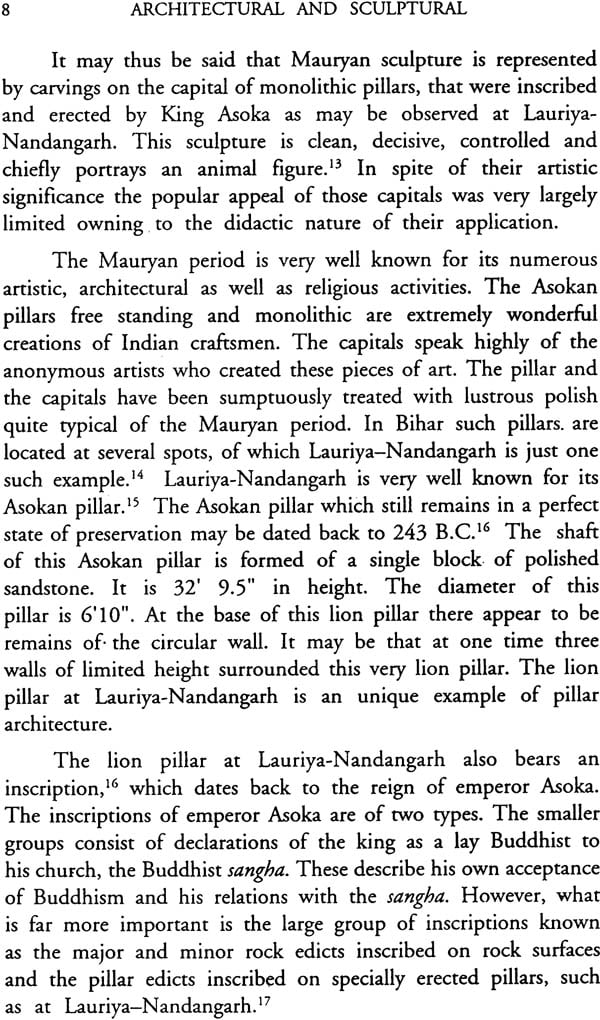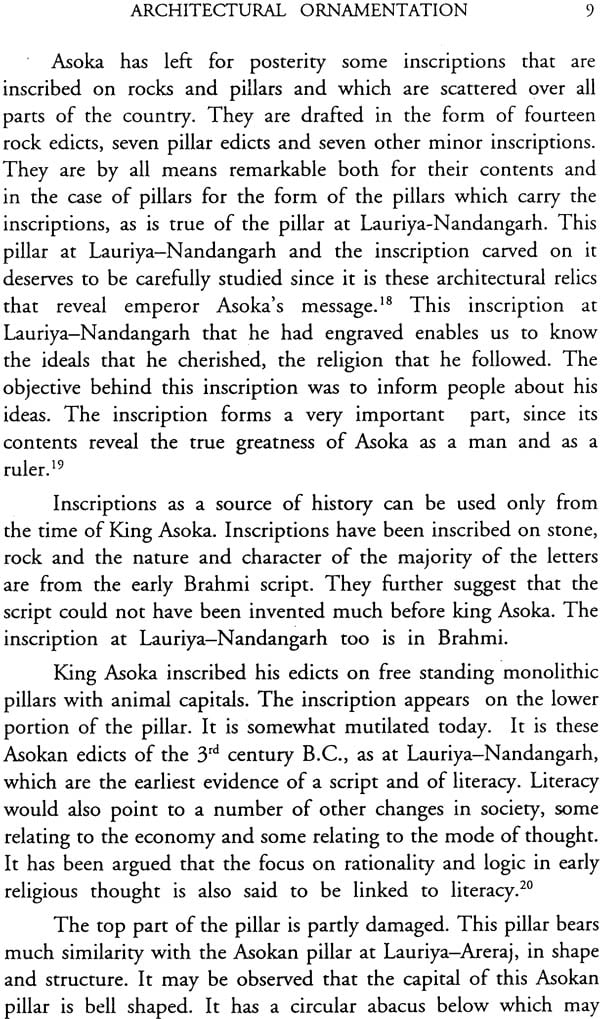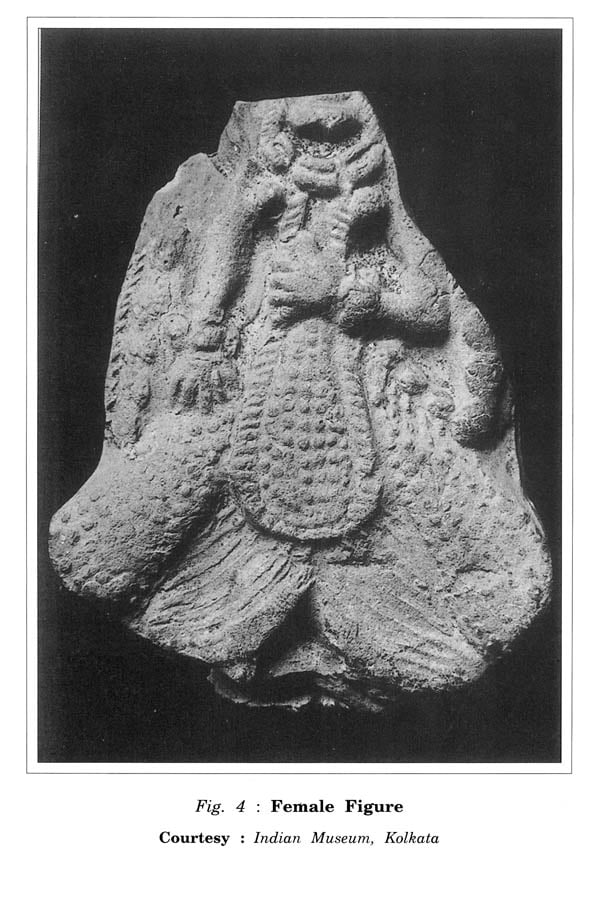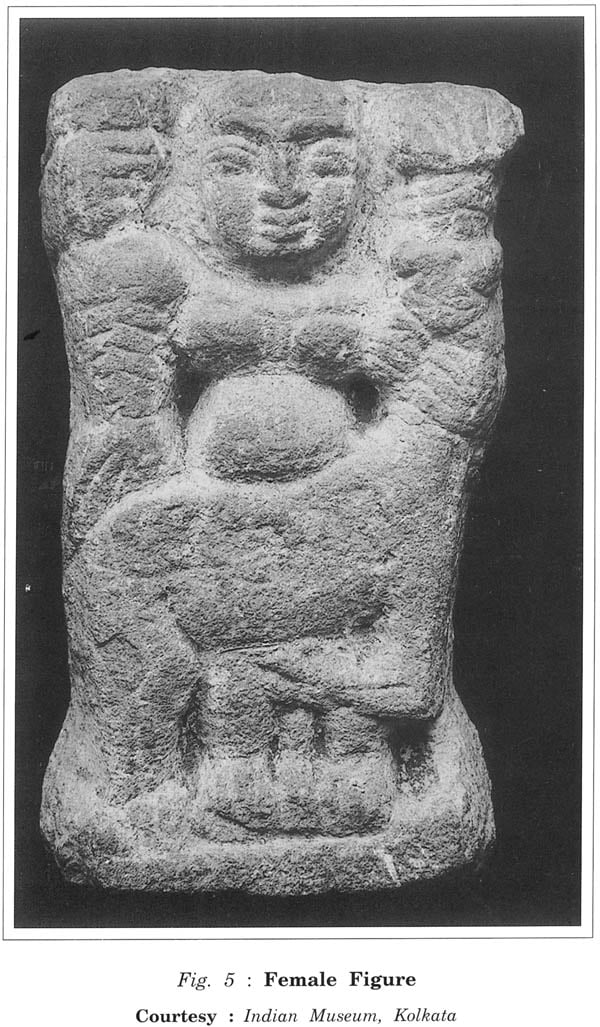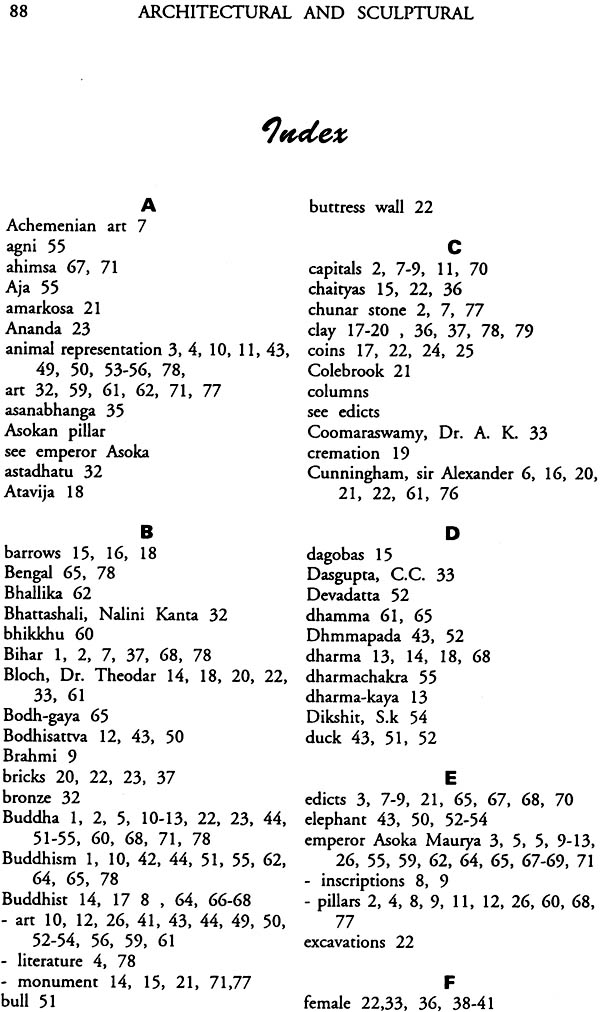
Architectural and Sculptural Imagery of Lauriya- Nandangarh (An Old and Rare Book)
Book Specification
| Item Code: | NAN664 |
| Author: | Balarka Batabyal |
| Publisher: | Bharatiya Vidya Bhavan |
| Language: | English |
| Edition: | 2003 |
| ISBN: | 8172763239 |
| Pages: | 102 (6 B/W Illustrations) |
| Cover: | Paperback |
| Other Details | 8.0 inch X 5.5 inch |
| Weight | 170 gm |
Book Description
Balarka Batabyal, a Bengali, born in Chittaranjan, West Bengal, is the son of an I.A.S. officer who served in the Maharashtra cadre since 1960. He was awarded Doctorate of Philosophy in Ancient Indian History and Culture, on the topic "Buddhist Monastic Centres of Eastern India, Circa, 6th to 12th Century A.D. A Socio-Historical Study" (1999), through Ananthacharya Indological Research Institute, affiliated to University of Mumbai. He took his Masters degree in Ancient Indian History and Culture, (1991), from St. Xaviers College, and a Bachelors degree in Ancient Indian History and Culture, (1988), also from St. Xaviers College, Mumbai.
Balarka Batabyal, has served as Lecturer, Department of History, Kirti.M.Doongursee College, Dadar (W), Mumbai; as Lecturer, in Government Law College, Churchgate, Mumbai; as Lecturer in Siddharth College, Fort, Mumbai; as Teacher in Swami Vivekanand School, Kandivli, Mumbai; as Sub-Editor, Free Press Journal, Nariman Point, Mumbai; as Principal, Shivai Vidyalaya, Thane, and as a Research Assistant with several organisations. He is also a Free Lance Journalist, and has written several articles on History, Textile Art, Citylights, Health, and also Literature in numerous city journals.
Balarka Batabyal, is deeply involved in creative writing. He has written numerous poems all of which have either been published in some city journals or recorded on All India Radio. He is deeply inclined towards music, art and literature.
Preface
The origin of this research work lies in my curiosity regarding the art and architecture of the Buddhist monastic site of Lauriya- Nandangarh. Lauriya-Nandangarh is located in District Champaran, in the eastern state of Bihar. It was while reading several books, regarding terracotta art pertaining to Buddhist monasteries of eastern India that I got to know about the Buddhist site of Lauriya-Nandangarh. A deep interest in the subject to a very large extent led me into several years of research work which then finally resulted in the completion of this book.
Lauriya-Nandangarh is a Buddhist monastic site of eastern India, on which not many scholars have ventured in the past. My primary requirements for this scholarly work, called for an empirical survey of the entire art and architecture of the Buddhist monastery of Lauriya-Nandangarh in stone, metal as well as terracotta. For this a visit to the Buddhist site of Lauriya- Nandangarh was indeed very essential. Similarly even a visit to the Indian Museum at Kolkata was also of great help in especially studying the numerous terracotta figures that are preserved in its galleries and obtained from Lauriya-Nandangarh. It is in the galleries of the Indian Museum, Kolkata that there still prevail numerous terracotta images from Lauriya-Nandangarh that are all still intact. Further, the monolithic pillars as well as the stupas at Lauriya-Nandangarh also reveal to us that Lauriya-Nandangarh must have been an important land route in connection with trade during the days of Emperor Asoka. Since it was he who had erected all these monolithic stone pillars at all important trade routes all throughout the country.
I have selected some photographs so as to reveal the architectural as well as sculptural findings in their proper perspective. It is in this context that I would like to thank the authorities of the Indian Museum, Kolkata, for providing ¬me with photographs. I would also like to thank Mr. Anil S. Chaddha, Mr. Sanjay S. Chaddha, and Mr. Rajesh S. Chaddha of the Indian Art Studio, Mumbai for the help that they have offered me.
I record my deep and sincere gratitude towards all authorities whose works have been of great help in formulating my thoughts and shaping my work. I am also indebted to various scholars who discussed or made suggestions on the subject at different stages of work. The work would not have been complete without the assistance of my father Mr. Arnar N ath Batabyal and my uncle Dr. Ani Kumar Ganguly, who need not be formally thanked. I take this opportunity to thank Mrs. S. Potdar, Miss Lata Ramaswami and Varsha Deodhar for providing me with facilities for research. Lastly Dr. Debala Mitra for providing me with ideas.
Further, I also take this opportunity to thank my Research guide for his assistance and kind co-operation, all throughout till the completion of this research work.
I would also like to thank the Bharatiya Vidya Bhavan and its Executive Secretary and Director General Shri Dhiru S. Mehta, for the keen interest they took to produce such a book worth of inclusion in the widely acclaimed Book University Series of the Bhavan.
Introduction
There are numerous religions that were born in India, and which are still prevalent. Prominent among them are Hinduism, Buddhism and Jainism. As regards Buddhism, it was founded by Gautama Buddha, at Bodh-Gaya, located in the state of Bihar. It was from here that it then rapidly spread all over the country and emerged as a dominant religion in the entire region of eastern India. In eastern India it has been seen that the religion of Lord Buddha had a very stronghold all throughout. With the royal patronage that it received from numerous emperors as well as wealthy traders and certain respective citizens, slowly Buddhist monastic centres which had such a great religious affinity became an important landmark for the merchant community. It was the traders who very widely patronized them. Ever since the days of Lord Buddha, with their modest inception these Buddhist establishments grew up• slowly in abundance, all throughout eastern India. Emergence of a large number of buddhist viharas at a subsequent period was possible due to the primary need for residence of innumerable number of Buddhist monks and nuns. At a later time however these became transformed into educational institutions. An ideal example being the University of Nalanda and also the University of Vikramasila, located in the state of Bihar.
Bihar may be described as the sanctum sanctorum of early Buddhism, since Lord Buddha's life as well as activities very largely centered around several places located in this state. The very nomenclature of which is after a monastery (vihara), which was the birth place of Lord Buddha's religion. Besides there are places located in Bihar, where the Buddha had delivered his discourses. Thus for the Buddhists it may be said that this region was propounded sacred since Lord Buddha had sanctified by his own footsteps many of its villages and towns. It was then that he propounded to the people of this land all the doctrines of his religion. One such place located in District Champaran, in the state of Bihar was Lauriya-Nandangarh.
A survey of Buddhist monasteries of eastern India, has been dealt with in the past. But a detailed and comprehensive study of the Buddhist monastery of Lauriya-Nandangarh is a long desired wish of many historians, since not many have taken it for research so far. The Buddhist site of Lauriya-Nandangarh was extremely prominent in India, mainly during the Mauryan period. In a study of the Mauryan period a sudden flood of source materials become available. Whereas with the earlier period of ancient Indian history there is a frantic search to glean evidence from sources which are often far removed and scattered. With the Mauryan period there is a comparative and abundance of information from sources contemporary or written, at a later date. This is because Magadh which was the homeland of the Mauryan emperors such as Asoka Maurya, (circa 269 B.C.-232 B.C.) was also the centre of their art activities? It was daring the years of he Mauryan rule a tradition originated of working in a common type of stone generally identified as Chunar sandstone. This anticipates the almost ubiquitous use during this period of eastern Indian gray black stone commonly identified as Rajmahal Schist. The pillars of emperor Asoka along with their animal capital's widely dispersed along the well travelled pilgrimage routes, trade routes, attest either to the movement of the finished work of art from a single centre to the various sites or more likely to the movement of artists themselves along this route. Much the same sort of movement took place in later times, as well, when the varying patterns of movement took places which also do provide an insight into the changing cultural boundaries. As the pattern may be documented by the find spots of the sculptures. It makes a small difference to the conclusion whether the artist moved or their finished products were transported. This was particularly the case during the reign of Emperor Asoka Maurya. Since apart from the unintentional evidences of sources such as religious art, architecture, coins and the edicts of king Asoka Maurya, inscribed on rock as well as on pillar throughout the country are available. These consist of fourteen major rock edicts and a number of minor rock edicts and inscriptions at numerous places all over India. Apart from these, also excavated were seven pillar edicts, of which one is the Asokan pillar at Lauriya-Nandangarh. Their purpose was naturally to make public the edicts of Emperor Asoka to a very large group of people as far as possible. The inscriptions usually cover a large mass of area. The pillar inscriptions may refer to commemorative events of some social as well as religious significance. But it is also true that some pillars have been removed from their original location. This undoubtedly prevents) the study of the objects and is to be regretted from the archaeological point of view. The eastern Indian sculptures very largely depict human and animal sculptures and are mainly dating back to the Mauryan period as may be seen at the Buddhist site of Lauriya-Nandangarh. The best specimens of these are the animal representations in stone such as the lion sculpture, which crowns the Asokan pillar at Lauriya-Nandangarh. Also excavated were numerous coins from several mounds.
| Dedication | v | |
| Preface | vii | |
| Chapter 1 | Introduction | 1 |
| Geographical Location of Louriya- Nandangrah | ||
| Placement of Buddhist religion and art | ||
| Necessacity od studying its historical development | ||
| Role of the Mauryan emperor Asoka | ||
| Religion and secular inspiration | ||
| Periodization | ||
| Chapter 2 | Architectural Ornamentation | 6 |
| Buddhist art of lauriya | ||
| Nandangarh | ||
| Pillar Architecture | ||
| Its imagery and also incriptions | ||
| Animal and floral carvings | ||
| Stupa Architecture | ||
| The Mounds at Lauriya | ||
| Nandangarh | ||
| Their Placement and Periodization | ||
| The numerous relic contents | ||
| Inscribed seal of the Gupta period | ||
| Marks of Indention and that of human relics | ||
| Chinese traveller Hiuen | ||
| Tsang's account | ||
| Large masses of Kushan coins with buddhist motives | ||
| Coins of Kujula Kadphies | ||
| Past Mauryan influence | ||
| Chapter 3 | Sculptural Ornamentation | 32 |
| Metal art finding | ||
| Gold leaf plaque | ||
| Rituals portrayal connected with the Mother Goddess | ||
| Erotic motifs and the concept of fertility | ||
| Opulent type | ||
| Same mother Goddess from Piprahwa | ||
| Gold leaf plaque its Chronology | ||
| The terracotta art of Lauriya- Nandangarh | ||
| Human and animal figures | ||
| Terracotta sealings | ||
| Figure of Goddess Lakshmi | ||
| Terracotta matrix | ||
| Numerous stone that have been excavated | ||
| Lauriya- Nandangarh as a metal castting centre. | ||
| Chapter 4 | Animal Representation | 49 |
| Significance of animal representation in Buddhist art | ||
| Independent sculptures | ||
| Architectural panels | ||
| Animal Representations at Lauriya- Nandangarh | ||
| Material composition | ||
| Periodizations | ||
| The animal sculpture of bull, duck, elepant, geese, lion, ram. | ||
| Chapter 5 | Material and Magnitude | 58 |
| Lauriya- Nandangarh and its numerous art material | ||
| Placement and Significance | ||
| Art material and the art public | ||
| A center for trade and economic activity | ||
| Expansion of trade and religion | ||
| Royal patronage from Mauryas and Kushan emperors | ||
| A trade route into Nepal as well as other neighbouring countries | ||
| Expansion of trade and religion | ||
| The site and its significance | ||
| Chapter 6 | Conclusion | 76 |
| Remnants of Architecture and Sculpture reveal how a grand a site | ||
| Emphasis on Terracotta art- A Great center of trade | ||
| Land route to several countries across the Himalayas | ||
| Economically inspired and religiously inclined | ||
| Bibliography | 80 | |
| Index | 88 |
Sample Pages
